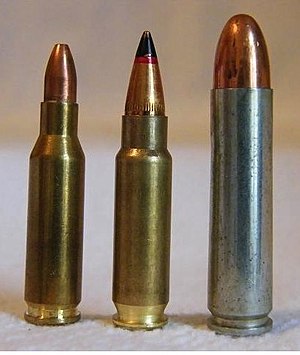4.6×30mm
| 4.6×30mm | ||||||||||||||||||||||||
|---|---|---|---|---|---|---|---|---|---|---|---|---|---|---|---|---|---|---|---|---|---|---|---|---|

From left to right: 4.6×30mm (Hollow Point), 5.7×28mm, .30 Carbine.
|
||||||||||||||||||||||||
| Type | Personal defense weapon | |||||||||||||||||||||||
| Place of origin | Germany | |||||||||||||||||||||||
| Service history | ||||||||||||||||||||||||
| In service | 2001–present | |||||||||||||||||||||||
| Used by | See Heckler & Koch MP7 Users | |||||||||||||||||||||||
| Wars | Afghanistan War | |||||||||||||||||||||||
| Production history | ||||||||||||||||||||||||
| Manufacturer | Heckler & Koch | |||||||||||||||||||||||
| Variants | See Variations | |||||||||||||||||||||||
| Specifications | ||||||||||||||||||||||||
| Case type | Rimless, bottleneck | |||||||||||||||||||||||
| Bullet diameter | 4.65 mm (0.183 in) | |||||||||||||||||||||||
| Neck diameter | 5.31 mm (0.209 in) | |||||||||||||||||||||||
| Shoulder diameter | 7.75 mm (0.305 in) | |||||||||||||||||||||||
| Base diameter | 8.02 mm (0.316 in) | |||||||||||||||||||||||
| Rim diameter | 8.00 mm (0.315 in) | |||||||||||||||||||||||
| Rim thickness | 1.10 mm (0.043 in) | |||||||||||||||||||||||
| Case length | 30.50 mm (1.201 in) | |||||||||||||||||||||||
| Overall length | 38.50 mm (1.516 in) | |||||||||||||||||||||||
| Rifling twist | 160 mm (1 in 6.3 in) | |||||||||||||||||||||||
| Primer type | Boxer Small Rifle | |||||||||||||||||||||||
| Maximum pressure | 400.00 MPa (58,015 psi) | |||||||||||||||||||||||
| Ballistic performance | ||||||||||||||||||||||||
|
||||||||||||||||||||||||
|
Test barrel length: 180 mm Source(s): HK USA HK USA Modern Firearms, Pistol / SMG ammunation Heckler & Koch Products |
||||||||||||||||||||||||
The HK 4.6×30mm cartridge is a type of ammunition used in the Heckler & Koch MP7 Personal Defense Weapon (PDW) and by the canceled HK UCP pistol. It is an indigenous German cartridge. It is designed to minimize weight and recoil while increasing penetration of body armor. It features a bottlenecked case and a pointed, steel-core, brass-jacketed bullet.
The 4.6×30mm cartridge was introduced in 1999. It was designed as a competitor to FN Herstal's 5.7×28mm cartridge.
Compared to standard intermediate cartridges one can carry more 4.6×30mm ammunition due to the lighter weight and relative small dimensions of the cartridge. Also, due to the lighter weight of the bullet, aiming in rapid fire is much easier as recoil depends much on the weight of the bullet. CRISAT testing shows that because of the smaller diameter and high projectile velocity of the round, body armor penetration is higher than that of traditional handgun projectiles.
The 4.6×30mm cartridge has been claimed to have low terminal effectiveness, especially by those who disagree with the "energy dump" theory of wound ballistics, such as Dr. Martin Fackler. Kinetic energy manifests itself in human tissue in temporary stretching of tissue, which most tissue except for liver and neural tissue is able to withstand with little ill effect. Slow motion videos show that the 4.6 mm bullet yaws at impact on soft tissue. This is because the center of mass of the bullet is behind the geometric center, causing the back to come forward at impact, and therefore tumbling through soft tissue, creating much greater damage, according to the "energy dump" theory.
A series of tests performed by NATO in the United Kingdom and France indicated that 5.7×28mm was the superior cartridge. The results of the NATO tests were analyzed by a group formed of experts from France, the United States, Canada, and the United Kingdom and the group's conclusion was that the 5.7×28mm was "undoubtedly" the more efficient cartridge.
...
Wikipedia
